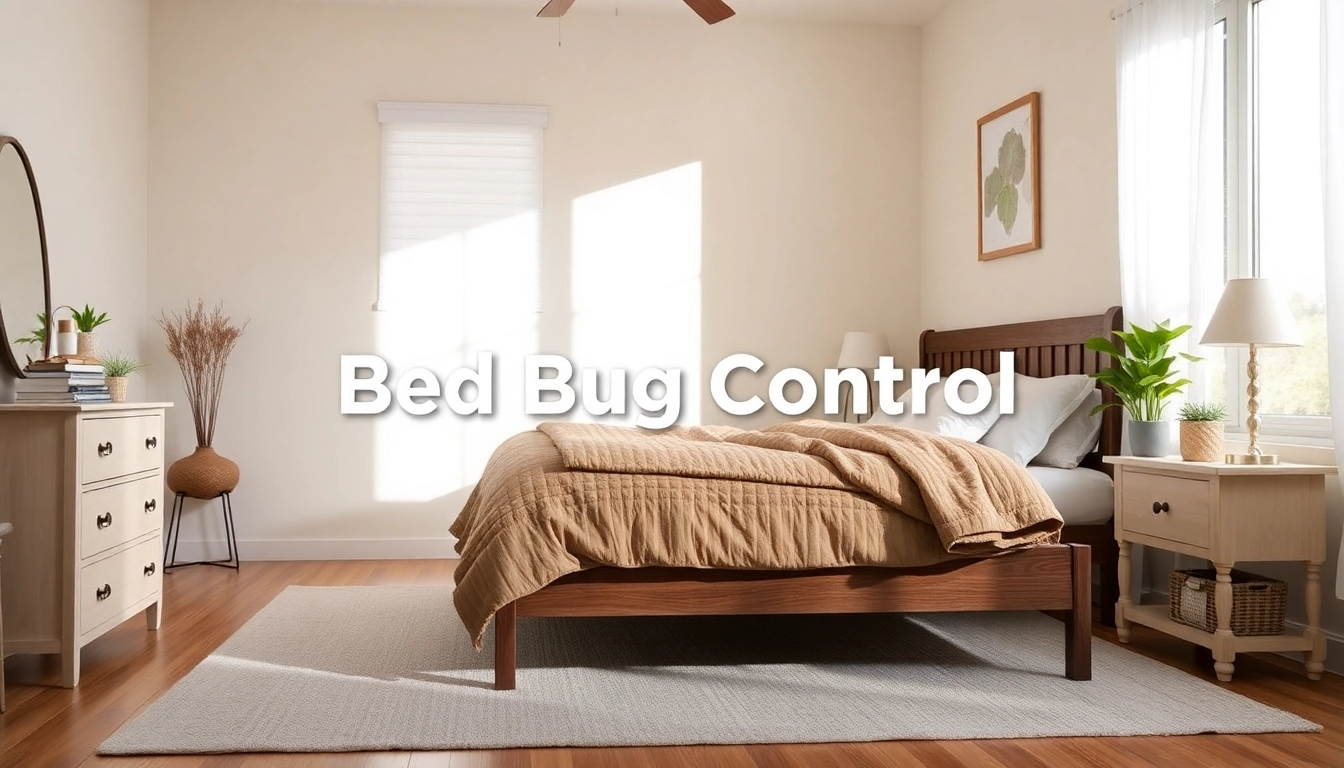
Understanding Bed Bugs and Their Behavior
Bed bugs are tiny, parasitic insects that feed on human blood, primarily at night. Their presence is not just a nuisance; infestations can lead to psychological stress and negatively impact your quality of life. For effective Bed Bug Control, it’s essential to understand these pests, their life cycles, and behaviors.
What Are Bed Bugs?
Bed bugs, scientifically known as Cimex lectularius, are small, reddish-brown insects that grow to about 4-5 mm in length. They are flat, which allows them to hide easily in crevices and cracks in bedrooms, furniture, and electrical outlets. Adult bed bugs are wingless, making them reliant on human intervention for transportation, often hitching rides on luggage, clothing, or used furniture.
Life Cycle and Habits of Bed Bugs
Bed bugs undergo a complex life cycle, consisting of five stages after hatching from eggs. These stages include:
- Egg: Bed bug eggs are tiny, about 1 mm in size, and are usually laid in clusters in hidden places.
- Nymph: After about a week, eggs hatch into nymphs, which resemble miniature adults but are translucent and lighter in color.
- Adult: With access to a blood meal, nymphs molt multiple times, eventually becoming adults capable of reproduction.
Bed bugs are nocturnal creatures and prefer to feed during the night, creating a challenge for identification. Each individual can live several months without a meal, allowing them to spread rapidly and become difficult to eliminate.
Identifying Bed Bug Infestations in Your Home
Identifying an infestation early is crucial for effective control. Common behaviors and physical signs to look for include:
- Presence of shed skins, which bed bugs leave behind after molting.
- Dark spots of fecal matter on bedding or walls.
- Itchy, red bites in areas often exposed during sleep.
Signs of Bed Bug Infestation
Common Indicators of Bed Bugs
Bed bug infestations manifest through various signs. Look out for:
- Red or dark stains on sheets caused by crushed bugs.
- Bed bugs found in seams of mattresses or safety crevices of furniture.
- Odorous secretions that can be described as musty or sweet.
Visual and Physical Signs to Look For
In addition to the indicators mentioned above, inspect your home thoroughly:
- Look under carpets, behind headboards, and inside nightstands.
- Check the corners of your bed frame, baseboards, and behind electrical outlets.
- Use a flashlight to search for hidden bugs, especially in the mattress seams.
When to Call an Exterminator
If you see persistent signs of bed bugs despite your efforts to eliminate them, it may be time to engage a pest control professional. Indicators that professional help is needed include:
- Abundant signs of bites or bugs despite DIY treatments.
- A rapidly increasing number of infestations in various rooms.
- Difficulty locating their hiding places.
DIY Bed Bug Control Methods
Preparation Steps Before Treatment
Before implementing any DIY methods, thorough preparation is crucial:
- Declutter your living environment to expose potential hiding spots.
- Launder and dry all bedding and clothing on high heat, which kills bugs and eggs.
- Vacuum carpets, floors, and furniture to remove adults, nymphs, and eggs.
- Seal vacuumed contents in bags and discard them immediately.
Effective DIY Techniques
A combination of methods can help curb infestation:
- Use mattress encasements that are bed bug-proof to trap and kill existing bugs.
- Apply diatomaceous earth around bed frames and known hotspots; it dehydrates and kills bugs.
- Use steam cleaning to treat carpets, furniture, and bed frames, ensuring temperatures reach 130°F (54°C).
Tools and Products for Home Use
Several tools and home products are effective for DIY pest control:
- High-efficiency vacuums (HEPA filters) and steamers.
- Bed bug sprays containing certified pesticides for supplemental measures.
- Bed bug traps to monitor and capture bugs effectively.
Professional Bed Bug Control Services
When to Consider Hiring Professionals
Some scenarios indicate that professional intervention is essential:
- If DIY methods have not yielded success after 3-4 weeks.
- For larger infestations that have spread beyond the immediate bedroom.
- If the infestation is accompanied by a population of resistant pests.
Choosing the Right Pest Control Company
When selecting a pest control service, consider these factors:
- Check for proper licensing and certifications.
- Review testimonials and ratings from previous customers for reliability.
- Inquire about the methods and products they use to ensure safety and effectiveness.
Understanding Treatment Options and Costs
Professional treatment options can vary widely in cost and effectiveness:
The typical treatment may include:
- Heat Treatment: Kills all bugs by heating the environment—highly effective but more costly.
- Pesticide Treatment: Involves chemical application and may require multiple visits for complete eradication.
- Integrated Pest Management (IPM): Combines various strategies including chemical and non-chemical measures, often tailored to the specific situation.
Preventing Future Bed Bug Infestations
Maintaining a Bed Bug-Free Environment
Preventing a re-infestation involves regular maintenance:
- Regularly inspect and clean your living areas, especially bedrooms and common spaces.
- Avoid bringing home second-hand items without thorough inspection.
- Use encasements on mattresses and box springs as a barrier against bed bugs.
Best Practices for Long-Term Prevention
To secure your home against future infestations:
- Implement a routine cleaning schedule using hot water and heat dryer cycles.
- Seal cracks and crevices around baseboards and furniture to close off potential habitats.
- Create inspection protocols for travel to notice new infestations early.
Additional Resources and Support
If you’re struggling with prevention or treatment methods, many resources can assist:
- The EPA’s guide on bed bugs provides excellent information.
- Local health departments may have pest control specialists available.
- Various universities offer research-backed resources on pest management strategies.